The Quick Explanation
Enemy is Denis Villeneuve’s Fight Club. Except it’s less explicit than Fight Club. It opts to show more than tell. So you never get the big, definitive reveal that Adam and Anthony are the same person the way we do with Edward Norton and Brad Pitt. Villeneuve lets a bunch of little things add up over time that make us realize Adam has been an unreliable narrator throughout the film.
So what’s this mean, in practical terms? Adam/Anthony is married to Helen, they’re about to have a kid, and he’s in the midst of a midlife crisis. He’s a teacher who moonlights as a movie actor. He’s a husband who has a girlfriend. He’s torn between lifestyles because he’s scared of falling into pattern and routine. There’s a realistic way to tell this story where we witness the character live his double life and the complications that arise. But that’s boring. By making the euphemism of a “double life” literally literal, the story becomes much more dynamic. This idea was first popularized by Fyodor Dostoevsky in a novel by that exact name, The Double, then followed up by José Saramago who expanded on the concept. Saramago’s version was the basis for Enemy.
The easiest way to watch Enemy is to understand that we’re essentially watching Anthony’s subconscious crisis. When people react to the double, like Helen reacting to Adam, or Mary reacting to Anthony, that’s not how they’re really reacting. Helen isn’t confused that Adam exists and looks like Anthony. That’s just how Anthony processes it. What Helen’s actually responding to is her husband’s inconsistent moods and wondering why he’s behaving differently than the man she married. Same thing with Anthony and Mary. They weren’t in a car crash. That was merely the subconscious dramatization of the end of their relationship. So that’s the foundation of what you need to know. Read on for more information about spiders and strange clubs and everything else.
Cast
Jake Gyllenhaal – Adam Bell/Anthony Claire
Sarah Gadon – Helen Claire
Mélanie Laurent – Mary
Isabella Rossellini – Mother
Tim Post – Concierge Bro
Denis Villeneuve – Director
Why it’s called Enemy? (And not after the book it’s based on)
Enemy is based on the José Saramago novel The Double. And Saramago’s novel is a nod to Fyodor Dostoevsky’s by the same name. Dostoevsky’s main character meets his dopplegänger and they go from friends to enemies as the other tries to take over the original’s life. So conflict was at the source of the foundational story. Saramago expanded on it. Instead of competing for the same life, Saramago has his dual characters swap, to disastrous results for the one (the car crash that happens in both the book and the film).
In both novels, the confrontation between doubles is nothing more than a metaphor for internal conflict. The battle between different parts of our identity. All of us deal with some form of this each and every day. It’s less dramatic in real life than in movies but that’s what fiction is for—to explore through exaggeration. In reality, you might be at your day job but dreaming about your true passion. Or you might live in the city but long to be in the country. Or you keep watching horror movies and it scares you why you’re so interested in disturbing stories. Denis Villeneuve could have called his movie The Double and it would absolutely work. For whatever reason, he audibled. Maybe it’s because Jesse Eisenberg had just been in a 2013 movie called The Double? Maybe he wanted to go beyond just the what and add an emotional charge? The character isn’t necessarily reacting to a double but to his own internal conflict. What’s the famous phrase? “Man is his own worst enemy.”
Who is the real person? Adam or Anthony?
This is important to clarify. While Adam is the character we meet first and Anthony is, initially, the “other”, I think Anthony is the “true” identity. Helen isn’t Mrs. Bell. She’s Mrs. Claire. Adam’s life with Mary is a far more recent thing than Anthony’s with Helen. Anthony and Helen go back years. While at the beginning of the movie we hear the mother say she’s not sure about Anthony’s new apartment. That would be the place “Adam” lives (because he’s separated from Helen) and has the affair with Mary. That explains why the apartment is so sparsely furnished. As well as Mary’s coming and going. The only established aspect of Adam’s life is the faculty webpage at University of Toronto Scarborough. It lists Adam Bell, not Anthony Claire.
There’s definitely a conversation to be had around this point. I’d welcome anyone trying to argue “No, Anthony Claire is just the actor name Adam’s using” or something. Regardless, this whole story is through the lens of an unreliable narrator. Things that happen are often just euphemistic or metaphoric, interpretations of reality rather than reality. Adam and Anthony don’t meet in a hotel room. They don’t have phone calls. It’s the equivalent to Brad Pitt and Edward Norton talking in Fight Club. It’s all a one-sided discussion externalized for the viewer. What’s really happening is Anthony’s struggling with himself. Trying to confront what it is he’s doing but still not willing to fully do so. So even though Adam Bell is listed it doesn’t mean that’s what’s really there. The reality is probably that Helen didn’t know Anthony was back to teaching (rather than acting) and was shocked by him not telling her. I know how annoying that sounds. But this is the kind of movie where you have to accept some of these things.
Why do we have to accept the style of Enemy?
This is a fun one. There’s an interview with Denis and Jake that’s tagged onto the end of the Prime version of Enemy. The two are very forthcoming. Jake starts off by saying: “I think the movie is about this search for intimacy. This search for being able to commit yourself to yourself and to relationships, romantic and otherwise.” The interview then clips in the scene of Adam telling the class about how “This is a pattern that repeats itself,” which is a very astute choice by the feature editor.
Denis: And the movie is designed so it can be either one man or two persons. For me, the story is about two men, but it’s a movie that is seen from the main character’s subconscious point of view, meaning that it’s about the story of one person but seen from the subconscious or it’s really the story of two men. It’s really that idea, 1 + 1 = 1, for me creates a kind of vertigo that I love.
I want to note here the difference between story and meaning. So it can sound like Denis is making it very clear there are two characters. But then contradicts that by saying it’s one person seen from the subconscious or the story of two men. Look back at, say, Sixth Sense, the story is about a kid and a child psychologist helping the kid deal with seeing ghosts. Until the twist comes and you realize it’s about a kid talking to a ghost. It’s the same thing with Fight Club. The surface level story as presented to the viewer differs from what’s actually happening.
If you ever learn about narrative craft, this duality comes up a lot. The story presented to the audience vs. what’s actually happening. Many movies and novels don’t distinguish between the two. But the ones that really leave room for interpretation and confusion and fascination purposefully create a divide that distances the audience from the truth.
Jake: Strangely, I feel like it’s a movie about one person and their search for themselves, you know, within the many people that we are and present ourselves to be in our everyday. And if we stop and take a moment to look at how we behave—good, bad, whatever—you’ll see that there are many different people inside of all of us. And I love the idea of someone who is split, and split so much that he became different things to different people and had to reconcile himself.
Denis: We play characters according to where we are in life and for me it’s about that too—identity… When Helen’s character meets Adam for the first time, for me it’s a key moment where one character will witness the duality. I wanted to express how for her it’s like if she was seeing an extraterrestrial. It’s really like a frightening moment and quite mesmerizing at the same time, hypnotic. It’s like she is deeply attracted by the other character but at the same time she is frightened. It’s like it’s something that is beyond logic, because what I love about it is that she sees her husband but it’s not the same soul. She feels it’s not the same man. And at the same time, the man she is in contact with is maybe the man she was in love with at the beginning. That’s what I love. There is something there. That’s a kind of thing that plays on the first level—there is a reality level, a subconscious level. What it’s describing—we are trying to play on all those layers at the same time…
Jake: There are a couple of moments when I am driving in a car with Mélanie Laurent’s character and taking her to the motel. And it was just, kind of, like, fun to play one character hating yourself. You know what I mean? And like wanting to kind of mess with yourself. I know it sounds kind of crazy but he is looking at her like he’s going to sleep with her—but he already has. It’s hilarious.
Denis: I think that the main thing for me is that [the audience] has to know it’s a movie that wants to be playful. It’s a movie that wants to play with your perceptions. It’s done in a way that provokes, so you have to go there with an open mind. It’s not the traditional way of telling a story.
What we get from this is that Jake clearly felt Enemy was about one guy going through some stuff. In another interview with The Hollywood Reporter, Jake said, “Enemy is about a man who is married, his wife is pregnant, and he’s having an affair. He has to figure himself out before he can commit to life as an adult.” That’s what’s happening. But the story, as presented to the viewer, involves all the exaggerated aspects of the drama and reaction to the drama. So that’s why you just have to accept some things in the movie aren’t happening how they happen but represent something far more mundane.
The themes and meaning of Enemy
Duality
The most obvious theme is duality and self-confrontation. What’s it mean to be more than one person? What’s it mean to not recognize yourself? It may seem hard to conceive of when thinking about it in terms of Enemy and running into this duplicate of yourself. Instead, think about a situation where you surprised yourself. I’m generally very talkative and confident, but I once had a job interview where I felt off from the moment I stepped into the office and found myself giving very quick, impersonal answers to questions. I was awkward. And of course didn’t get the job. Why was I suddenly not myself? What caused me to act differently than I expected? The truth is, we all have the capacity to be more or less than we usually are. Where we are and who we’re with can change how we behave. It can be jarring to discover these wrinkles in our self-perception. Especially when they evolve to more than random events and begin to define us. Like someone who discovers they love cooking and begins to shift their time and attention from other areas of their life to cooking. Maybe they quit their book club or fantasy league because they’re spending time cooking. Maybe they stop seeing other friends because they’re making new friends who also love to cook. Maybe they move to a city with more culinary options. Their entire life is unrecognizable because a new personality trait emerged.
In psychology, there’s something called Inner Child Work based on the idea that our past selves don’t just disappear over time. Who you were as a kid is still part of you. Who you were in middle school is still part of you. High school. College. Twenties. Thirties. On and on. While Inner Child Work focuses more on, as the name implies, childhood, the idea is applicable through all stages of life. This area of therapy often involves the present self addressing the past self. Even though you’re talking to yourself, you’re talking to this other you. With the hope that there’s some kind of catharsis or discovery or increase perception that benefits you in the long run. Enemy is basically an externalized version of this process. Anthony and Adam needed to confront one another in order to find closure and direction, one way or another.
Adam embodies a lot of Anthony’s softer side. He’s thoughtful, intelligent, considerate, shy, reserved, boring. He turns from people more than he seeks their attention. While Anthony is loud. He wants attention. He is egocentric. He talks to Helen more than Adam talks to Mary, but Anthony doesn’t actually talk to Helen. He just speaks because he likes to hear himself talk. Despite the negatives, he’s confident and capable in a way Adam isn’t. (Look at the image below and how Anthony’s in shadow and Adam’s in light. They’re consistently lit like this whenever they’re together).

Knowing what we know about the characters, it’s funny Anthony is with Helen and Adam with Mary. I mean, it’s Anthony with both, right? But you wouldn’t imagine the “Adam” aspects of Anthony’s personality to be the cheater. But I think this represents how when you cheat, it’s not just physically. There’s an emotional component as well. You’re giving someone else the care, attention, and compassion typically reserved for your significant other. And we see that Adam is that part of Anthony. So when Anthony’s having this affair with Mary, it’s like that part of him is no longer there. It’s with the other woman. Which is why Helen is so mesmerized by Adam. That’s the part of her husband she’s missed. It’s the part of Anthony she wants back.
So when Adam goes over to Anthony’s apartment and pretends to be Anthony, it’s really just Anthony choosing to be with his wife rather than his mistress. And that awkwardness of being a cheater who isn’t sure his wife will forgive him. But he’s trying his best to be kind, again. To ask about her. To provide for her. To give her the warmth and affection he had yielded to another. When Helen accepts Adam, she’s really just recognizing in Anthony this return to the man she fell in love with. That’s what Denis meant when he said, “The man she is in contact with is maybe the man she was in love with at the beginning.”
Control and Pattern
The lecture Adam gives to his class about pattern and control is nothing more than telling the viewer “Hey, these are important thematic concepts..”
We hear it once:
Control. It’s all about control. Every dictatorship has one obsession, and that’s it. So, in Ancient Rome, they gave the people bread and circuses. They kept the populace busy with entertainment. But other dictatorships use other strategies to control ideas, the knowledge. How do they do that? They lower education, they limit culture, censor information. They censor any means of individual expression. And it’s important to remember this, that this is a pattern that repeats itself throughout history.
Then immediately hear it again, with some variations:
See, every dictatorship—there’s always one obsession, and that’s control. They want to have control over the people. In ancient Rome, they, they gave…uh…bread and circuses. They kept the populace busy with entertainment. In other dictatorships, they have other strategies. To limit information, to limit ideas and knowledge. And how do they do that? They lower education, limit culture, they censor any means of self-expression. But it’s important to remember this: this is a, this is a pattern that repeats itself throughout history.
By repeating the speech, the movie tells us Adam is the one stuck in a pattern. Which begs the question, is he being controlled by someone else? Between and during the speeches, the film cuts from the classroom to Adam’s day to day life. It’s bland. He goes to and from work. His apartment is almost barren. It’s devoid of decoration. Barren of personality. There is no culture. No individual expression.
THE VERY NEXT SCENE is Adam in the faculty lounge. Get a load of this conversation:
Man: You don’t go to the movies, do you?
Adam: The movies?
M: Yeah, are you a movie guy? In your free time, I mean.
A: I don’t know. I don’t…I don’t…I don’t…I don’t go out that much. I don’t…I don’t really like movies.
M: Well, you don’t have to go out to enjoy a good flick at home.
A: That’s true.
M: I usually just rent them, yeah. I think most people don’t these days, you know, but, well, that’s what I do.
A: Is there a reason why you’re asking me this?
M: No.
A: Just cause you brought it up, and I thought, you know, maybe you had a recommendation or you had saw a movie that you liked and you want to tell me about it, or—
M: Oh, well, sure. I mean, yeah, there’s always, always something.
A: I could go for something cheerful.
M: Where There’s a Will, There’s a Way.
A: That’s true.
M: No, it’s a movie. I saw it a little while ago, but, um, yeah, I remember, uh, you know, it was…I liked it.
This, of course, is the movie Adam then rents that leads to his discovery of Anthony. Narratively, it might seem a little contrived to get this kind of recommendation to advance the plot. But, thematically, think about Adam’s lecture. Dictatorships do what to control ideas? They limit culture. What is a movie? Culture. It’s art. Expression. We know that Adam is stuck in a pattern and living this very boring, controlled life. That a movie breaks him out of that pattern and causes the existential journey between him and Anthony is perfect.
What’s that actually mean, though? Since we know Adam is Anthony and that stuff like this is actually more subjective and metaphoric than literal. I think it represents Anthony’s effort to lie to himself. Adam feels a lot like Anthony’s moral consciousness. And it’s like he’s been able to, for a time, distract his moral compass with work and pleasure. To forget about the ramifications of cheating on his wife by completely “forgetting” about his wife. People do this all the time. We lie to ourselves about how serious something we’re doing or not doing really is. You know that you’ll disappoint someone if you do some thing or don’t do another thing. But because you really do or don’t want to do it, you convince yourself it’s okay.
For example, you and your spouse are saving up for a vacation but you talk yourself into buying new, $200 shoes. The whole way home, you come up with reasons why it’s okay. You’re working more hours next week. You’re not spending money on something else. You got a great deal and wouldn’t be able to afford these otherwise. You’ll let them spend $200 on something they want. $200 isn’t that much, after all, is it? But as soon as you get home and talk to your spouse, you know you messed up. It’s not about the price. It’s not about making up for it. It’s about the fact that your spouse has been forgoing, too, because they thought you were in this together. It’s about the failure to communicate and going behind their back. Now, suddenly, you feel awful. In hindsight, all the reasons you had seem stupid.
This displacement of our better judgment is quite common. And is essentially what Adam represents. Enemy thus positions consciousness as a governing body that can, at times, be a dictatorship that subjugates other voices. That our wants and needs often struggle against our morals and conscience. Implicit in this is the opposite of dictatorship. The more inclusive forms of government like democracy. It makes sense to me that a more democratic approach to decision-making is healthier. But that’s the thing about crisis: when you’re in the midst of crisis, democracy kind of goes out the window. The dictator seizes control and you struggle to find peace and stability once again. So Enemy is really about Anthony’s moral revolution in the aftermath of crisis. With Adam representing the noble insurgent that ends the pattern and seizes back control for the people. In this case, the “people” being Anthony’s better judgment.
Women and Spiders
The first scene in Enemy is Anthony in an empty car, back to the camera, face reflected in the rearview mirror, listening to a voicemail from his mother. What you get there is transcience (being in the car), duality (reflection), guardedness (back to us), and male-female dynamics (mom on the phone). Bonus points that it’s a voicemail, meaning Anthony ignored the call. That implies a distance that’s reinforced by the cut to Helen sitting in bed, pregnant, nude, and alone. So we see that Anthony isn’t just evasive of his mother but also his wife.
Then we cut to his arrival at the underground club. A collection of fashionable, quiet, mesmerized men. Women perform for them, a display of enchanting deviance. What gets Anthony isn’t the first act we see but the second. A beautiful woman disrobes, revealing herself to the room, then an assistant pulls the lid on a silver platter. There’s a tarantula. Massive for a spider but diminished by the room, by the men around the stage, by the woman in heels who towers over it. Her foot descends toward the spider and the viewer anticipates the crush, the squash, the rupturing. But we cut to Anthony, hands on his face, enamored more than maybe anyone else in the room.
You don’t start a movie this way and not intend to make a statement about men and women. You have Anthony and his mom. Anthony and his wife. Anthony and his desires. These are three major influences. Not to mention that the scene in the underground club involves a lot of reflections and stars mostly blonde women. And that Helen and Mary are both blonde women.
Spiders appear four times in Enemy. First at the club. Second is the dream sequence when a woman walks down a shadowed hallway, she has the head of a spider but the nude body of a model. Third, when a shot of the city includes a giant, kaiju-sized spider monster roaming Toronto. Fourth, when Helen transforms into a huge tarantula. What’s interesting is that this was not part of the book. It’s something Villeneuve included to add another thematic layer to the proceedings. Of note, the citywalker spider is done in the style of Louise Bourgeois. So much so that I’d argue it’s a direct reference to Bourgeois’s work. Specifically, a sculpture she did in 1999 called Maman.
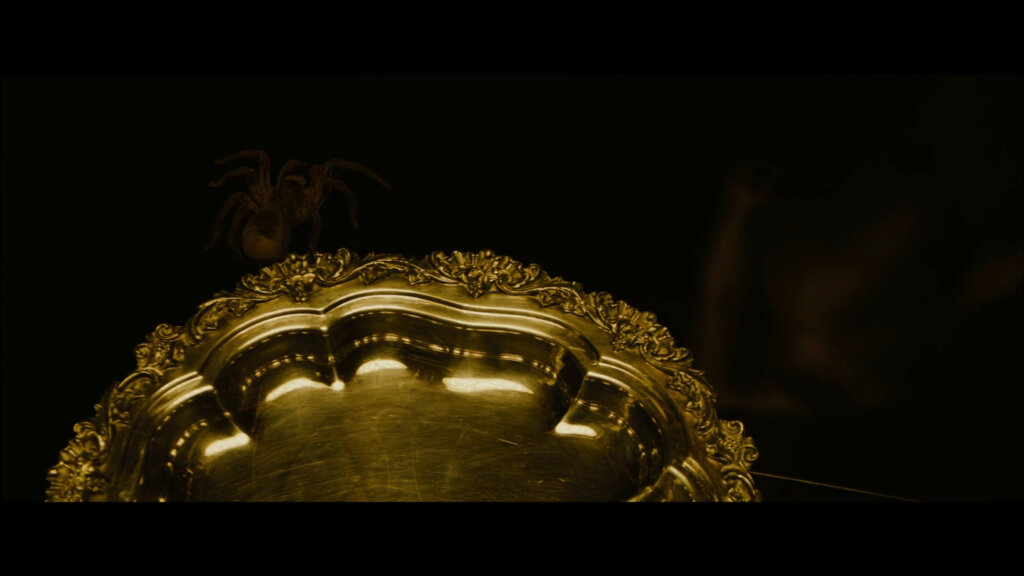
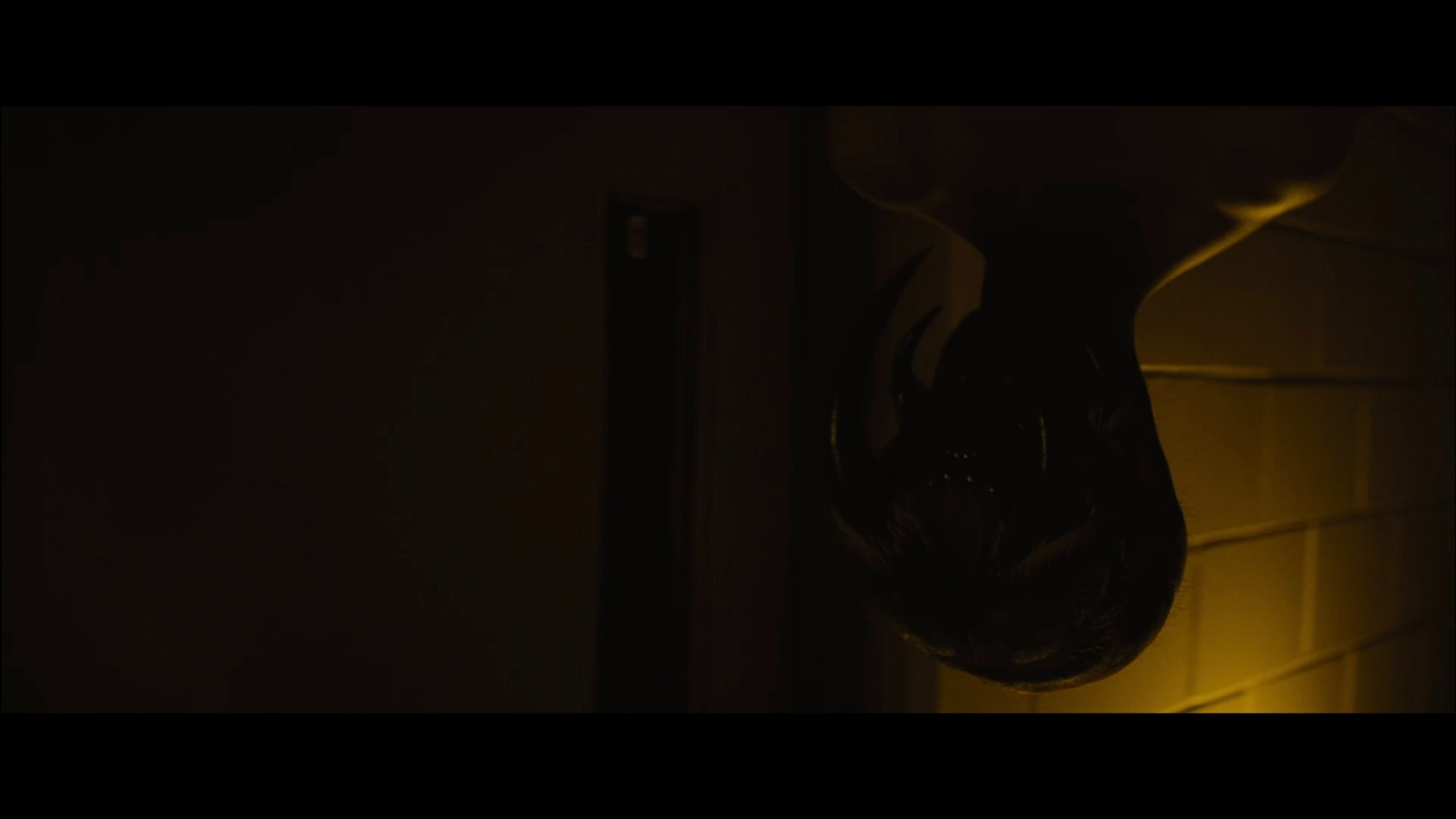
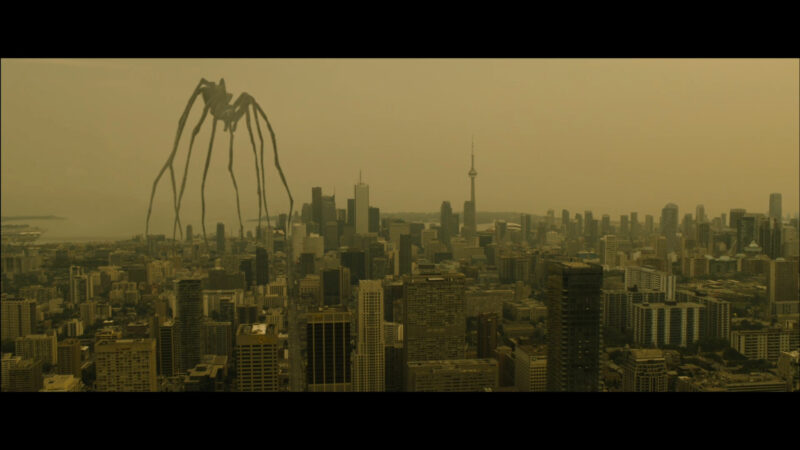
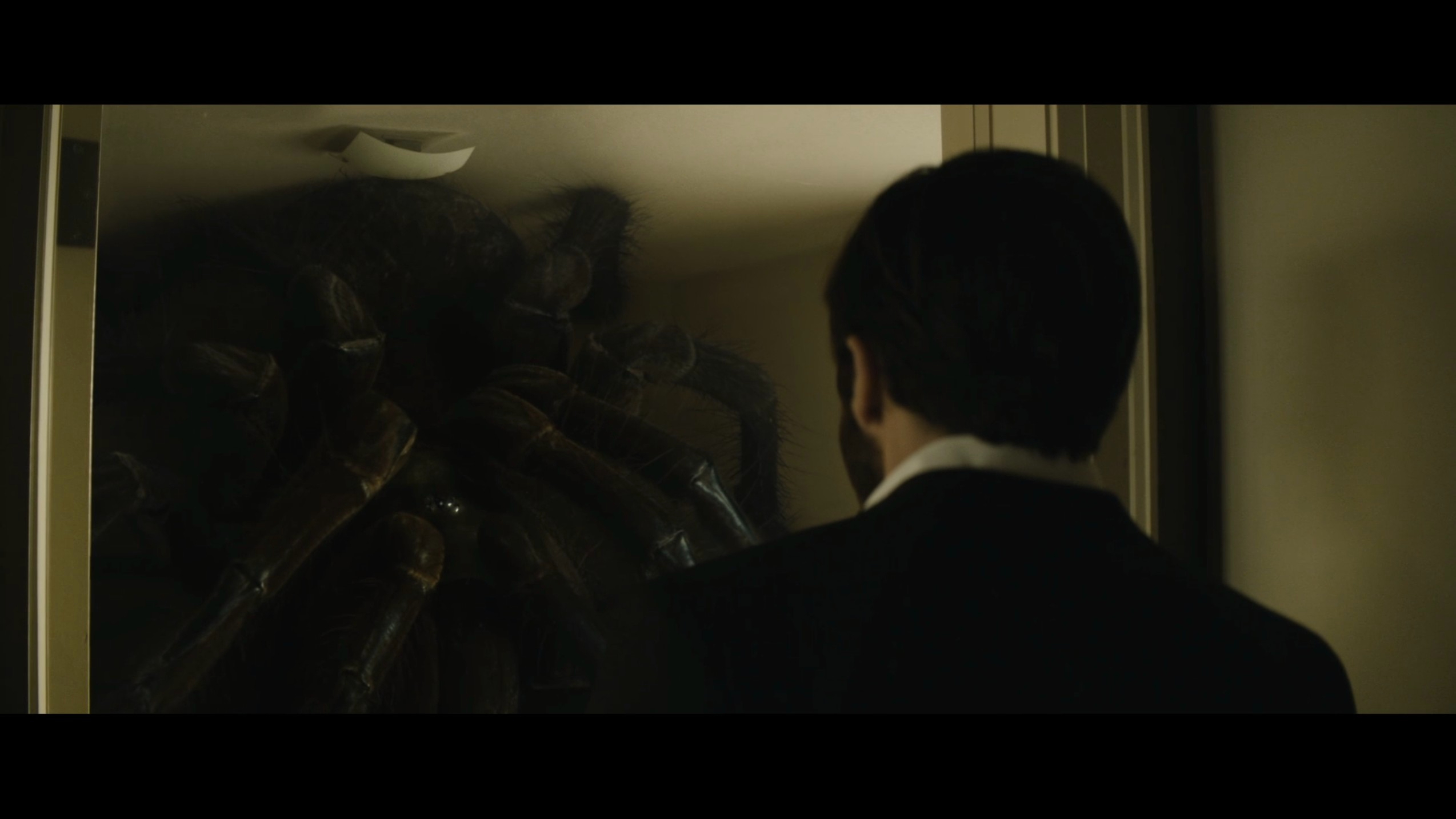
Oh, wait, I just stopped writing and googled it and Denis says in this interview: “When I thought about the spider, there was something specific I was looking for, the feeling from this beast, and that main thing was intelligence. I wanted to see that the spider was a beast that has the characteristic of a strong intelligence, and elegance. The best example that I found was this Louise Bourgeois sculpture [Maman]. We tried tons of different designs, but it always came back to this one. So, yes, it’s inspired by Louise Bourgeois.
After the interviewer asks about the connection between the city spider and Anthony’s mom, Denis says: “It’s something we worked a long time on. We had to make it more dynamic at one point, but this idea of the spider and the mother was a link that was a bit more obvious in the screenplay [and] had to remove. Because I think it was too obvious. The way we approached this movie was very pretentious [laughs] because we were trying to do it on a concrete level and on the subconscious level at the same time. So it affects the audience on both levels.”
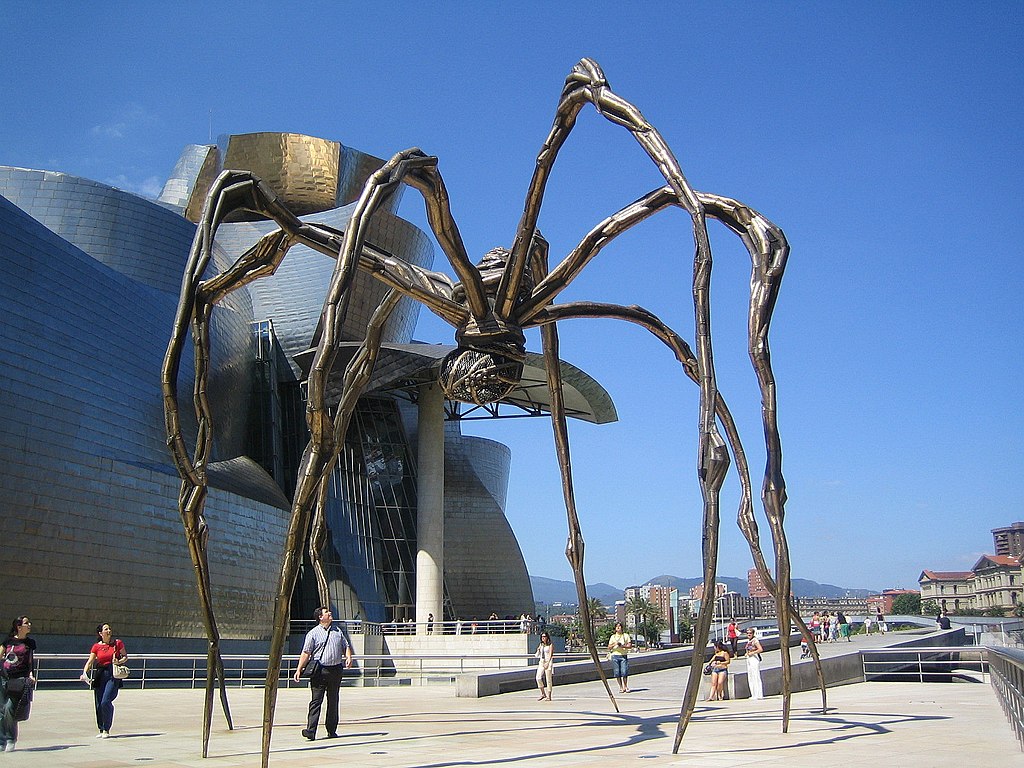
Regarding Maman, Bourgeois herself said, “The Spider is an ode to my mother. She was my best friend. Like a spider, my mother was a weaver. My family was in the business of tapestry restoration, and my mother was in charge of the workshop. Like spiders, my mother was very clever. Spiders are friendly presences that eat mosquitoes. We know that mosquitoes spread diseases and are therefore unwanted. So, spiders are helpful and protective, just like my mother.”
Notable is that when we see the citywalker spider for the first time, it’s after “Adam” meets with his mother. So you have the stage spider that’s associated with lusts and carnal appetite. You have the citywalker spider associated with the mother. Then, lastly, the Helen spider. Denis already said he associates the spider with intelligence. If we extrapolate from that, what’s it mean when the woman on stage stomps on the spider? Do we take this as the beginning of Anthony’s poor decision-making? A lack of intelligence? A separation from the protection of mother and wife? Or even a craving to destroy or separate from mother and wife?
Conflict is at the center of this. Anthony’s mom disapproves of the apartment he buys to be with Mary. She disapproves of his acting. She’s powerful and chastising. While Helen is expectant. As Anthony’s wife, there are certain expectations. That Anthony will be a partner, a friend, a lover, present and attentive. That he’ll help provide and support. These responsibilities inspire many people. But they can become a burden on others. Anthony buckles under the weight of expectation. Runs from it.
So as much as Enemy is about this inner conflict and duality and identity, it’s as much about marriage and maturity. Can you accept the pattern of responsibility? The routine of being faithful and present and giving to someone else?
The end of Enemy explained
Recap
“Anthony” pretends to be “Adam” and goes off with Mary under the pretense of a weekend getaway. Everything seems fine, but, once at the hotel, once the two begin to be intimate, Mary notices the wedding ring tan on Anthony’s finger. She knows Adam doesn’t have that so freaks out. She can’t explain who this man who looks like Adam is but it’s not him. So she demands Anthony drive her home. On the way back, “Anthony” freaks out and ends up crashing, annihilating the car, Mary, and himself.
Meanwhile, “Adam” pretends to be “Anthony” and goes to see Helen. It’s immediately and absolutely clear to Helen that this isn’t Anthony. Adam’s too sweet. Too considerate. Welcoming his compassion, she invites him to bed. And things go better for them than they did with Anthony and Mary. Helen, cradled by Adam, head on his shoulder, even asks, “Did you have a good day at school?”
The conflict with Anthony/Mary cross-cuts with Adam waking up in the night, seeming stressed, then going out to the living room in the dark. Helen comes out to him and asks him what’s wrong as he cries. Helen actually takes his hand and comforts him. As Adam apologies to Helen, the fight in the car between Mary and Anthony ramps up. Helen even says, “I want you to stay.” The physical ramp up between Adam and Helen escalates in tandem with the fight between Anthony and Mary. The climactic intimacy between husband and wife contrasts with Mary telling Anthony he’s not a man. This challenge to Anthony’s masculinity leads directly to the fatal crash.
The next morning, Helen showers and listens to the radio. “Adam” opens up the letter for Anthony and receives a key and instructions for the next underground event. The one his friend had begged him to go back to. We get parallel shots of Helen in the mirror wearing white and Adam in a mirror wearing black. Helen’s room is bright. Adam’s is shadowed. Helen mentions that Adam’s mother called and he should call her back. (Note: the key, Helen’s nakedness, and the call from the mother all circle back to the very first scenes of the voicemail, Helen alone on the bed, and the underground club).
A song plays on the rado. Adam wrestles with what to do about the key. Does he give in to temptation or let it go? Then he speaks and you know his decision has been made. “Helen, did you plan on doing something tonight? Cause I think I have to go out? Helen? Helen?” With no response, he walks into the bedroom where Helen had just been. In her place is the giant tarantula. It’s huge. Eight-legged. Multi-eyed. Cowering in the far corner of the room. Instead of Adam being scared of it, the spider is scared of Adam. He stares without reaction, sighs, and we cut to black.
What’s the ending mean?
Okay, this is fun. I promise. Remember, things that happen in Enemy are mostly metaphorical, with some moments of reality snuck in. Anthony and Adam aren’t two separate people. They’re both Anthony Claire. Except Adam represents Anthony’s heart, while “Anthony” is more of the ego (and id for you psychology fans). As we said in previous sections, the reason Adam is separate is that Anthony and Helen are in the midst of this problem period in their marriage. Anthony’s midlife crisis has caused him to distance himself from her. To go so far as to get another place and a girlfriend. The “heart” has gone out of the marriage. We’re shown the literal example of that concept by Adam’s distance and ignorance of Helen. Anthony’s spending more time with Mary. So it makes sense that his “heart” is with her rather than Helen.
The car crash isn’t real. Even though we hear about a crash on the radio. The crash is merely symbolic of the end of Anthony’s relationship with Mary. Whatever he was trying to prove by dating her, whatever midlife lust he had to get out of his system—it’s over. They’re done. She’s gone. When Helen says to Adam, “I want you to stay,” she’s not telling Adam she wants him to stay. She’s telling her estranged husband to stay at their place rather than go back to his apartment. The implication being they’ve had such huge issues that he’s rented a second place where he often goes to give them some space. By staying at home, it seems he’s picking the life with his wife over his identity crisis. His wandering, wayward heart has returned to his marriage.
That brings us to the next morning. As we talked about earlier, the movie opens with three main forces: mother, wife, and mistress. With the mistress represented by, first, the underground show with the spider, then Mary. Now, those forces collide once again. Helen mentions Anthony’s mother had called. Anthony has the secret invite to the underground club. And Helen is right there.
Full circle moments like this are designed to show contrast. In an uplifting movie, the contrast is positive. Look at Ebenezer Scrooge in A Christmas Carol. He begins the story as a miserly, mean, bitter old man who is a jerk specifically to his employee, Bob Cratchit. But by the end of the story, Scrooge spends Christmas with the Cratchit family. The early antagonism displayed by the character sets up the eventual kindness. In A Goofy Movie, Goofy can’t connect with his son, Max. Max refuses to even let his crush meet his dad. But at the end of the movie, the two bond, appreciate each other, and the last scene is Max introducing Roxanne to Goofy.
In a tragedy, you might have something positive turn negative. Like a couple is newly married and happy but at the end they’re signing divorce papers. But it might also be a return to how things were. Like a character begins lonely, living alone in an apartment, meets someone, falls in love, gets married, buys a house, but then they make some bad decisions that result in the end of the marriage. The last scene is them returning to the same empty apartment they lived in at the beginning. Something about the full circle is as compelling as it is satisfying.
So in Enemy, we’ve come full circle with Anthony. He started fractured. Went through the whole Adam/Anthony journey. Ended up reconnecting with his wife. And it seems like things will be better. All he has to do is NOT REPEAT THE SAME BEHAVIORS THAT COMPLICATED HIS LIFE IN THE FIRST PLACE. Put another way: break out of the pattern. How? Call his mom back. Throw away the key. Stay committed to his life with his wife. Instead, what does he do? He begins to weave another lie. He thinks he has to go out? Get real. He wants to go to the club. He’s falling victim to his carnal vices. Again. It’s the same thing that got him in trouble in the first place. What’s it mean, then, when he sees Helen as the spider?
The Spider
I think there are three primary interpretations. One positive. Two negative. The positive interpretation relies on how entranced Anthony was at the underground club when he saw the woman and the spider. Clearly that interaction made an impact on him. And even his apartment concierge who was there with him, that guy was going on about how much he needed to go back to the club. Whatever happened there, it mesmerized them. That scene connects the spider to Anthony’s vices. He even has that dream that takes place in the hallway outside the club, where a mysterious, beautiful woman walks towards him. Except she has the head of a spider. That mixture of woman and spider haunts him. So when he sees Helen as the spider, you could argue it means he’s once again seeing her as something to lust after. That he no longer has to go to the club for the spider and the woman. He has a spider-woman right at home.
Except if that was the case, why does the spider cower how it does? It’s frightened of Anthony. There’s nothing alluring about its presence. Which leads to the more negative interpretations. Instead of seeing the glass-half-full in Anthony’s perception of Helen as a spider, you could read it as him simply having lust-goggles on. That he’s no longer seeing his wife as his wife or even as a woman. He’s dehumanized her to an object that brings excitement. That maybe he’s dehumanizing all women, associating them only with his more base desires.
The last interpretation relies on decoupling the spider from lust. It wasn’t the spider itself that caused Anthony’s excitement but a woman stepping on the spider. We heard how Bourgeois thought of the spider as representative of her mother and her mother’s positive, nurturing qualities. And Denis talked about his views on the spider embodying femininity and intelligence. We already surmised that Anthony has struggled with the responsibilities of being a husband and soon-to-be-father. Struggles to live up to his wife’s needs, wants, and expectations. We also know the citywalker spider appears after Anthony talks with his mom. And the spider-headed dream woman appears after Anthony’s first big fight with Helen. Helen asks Anthony “What’s happening?” and he says “I really don’t know what you’re talking about?” She, crying, says, “I think you know. I think you know.” Then we immediately cut to the spider-headed woman.
During that fight, Helen was preceptive. While Anthony was trying to lie. You could argue that the spider-headed woman is emblematic of Helen’s increasing awareness about Anthony’s lies. She’s not just this brainless object of feminine sensuality that Anthony wants her to be. The spider represents female perception and savvy. Which is why Anthony was so enamored by a female crushing a spider, because it represented the woman’s willingness to throw away her own agency and be only what these men wanted her to be. I feel gross just writing that. But Anthony’s not a good guy. While we like Adam and kind of feel bad for Adam, ultimately, it’s “Adam” who decides to be just like “Anthony” and choose the club over his wife.
That’s why Spider Helen cowers in the corner of the room. She knows exactly what Anthony’s doing. He’s lying to her again. She thought the man she loved had returned to her. That he was ready to once again be her husband. But he’s not. He had the choice to reject the key, but he gave in to it. And now she’s not just a woman with the head of a spider. She’s full spider. Perceptive, protective, powerful. I love the contrast, too, with Anthony’s mom. The mom is older. By age alone, you know she’s experienced a lot. So her spider representation towers over the whole city of Toronto. It befits her knowledge. Helen is younger. Going through something like this for the first time. It’s a trial by fire. But she’s becoming wise herself. And is about to be a mother herself. So her spider form isn’t as colossal as Anthony’s mom. But it’s big enough to realize Anthony’s a lying jerk.
Reinforcing this negative interpretation of Anthony is the song that plays on the radio. The lyrics go like this:
My silent little room is growing dim
And the man next door is saying what a lousy day it’s been
And the clock on the wall
[something about ticking]
In the room below, the girl’s crying for her guy again
After the lights go out, what will I do?
After the lights go out, facing the night without you
Remember, this isn’t just a random song. Villeneuve said it himself, he was being extra pretentious with this movie. So you know the song was picked for a reason. It doesn’t seem positive, right? The room is little and growing dim. The idea of shrinking and shadow doesn’t imply happiness. Rather, it channels a sense of sadness and loss. Then you have a line that’s literally about a girl who is crying because of her guy. And a last line that talks about “facing the night without you.” That’s three lines that indicate a sense of loneliness and loss. If Enemy had a happy ending where Anthony was over all of his issues and ready to recommit to Helen, is this the song that should be playing? No. It doesn’t fit that vibe. But it absolutely fits the vibe of a relationship that’s about to end.
WITH THAT SAID. In the interview with Film Comment, Denis did say, “When somebody asked me recently to explain the movie, I said: ‘You know what, this movie is a very simple story. It’s a man who decides to leave his mistress and go back to his wife, and we see this story from his subconscious point of view.’ … It’s the simplest story but told in a very complex way.”
So I do think there’s some openness there, still, regarding Spider Helen. Is Anthony toast? Is he just going to have to work extra hard to win her trust back? Or is this supposed to be a nice thing where she’s now both his wife and the object of his lust? But I lean more toward Anthony screwing up his chance at redemption and Spider Helen being a protective mother who has finally decided to leave him.
I think that ending is a nice inversion of the dictator conversation at the beginning of the movie. As much as we applied that to Anthony, he’s the one who has tried to control Helen. He lies to her all the time. He’s wanted to keep her in the dark about his work, his girlfriend, his club. At the end, when he has a chance to break the pattern of his own behavior, he ends up reinforcing the pattern and essentially kicking off the whole movie again. The missed call from his mom and the option to go to the club bring us full circle. Anthony’s the dictator. And Helen is finally wise to him and she will be (hopefully) the one to actually break the pattern by breaking up with him.
One last thing
I thought this was cool but wasn’t sure where else to include it. We talked about the cross-cut between Anthony and Mary’s crash and Adam and Helen’s hook up. Look at these two shots.
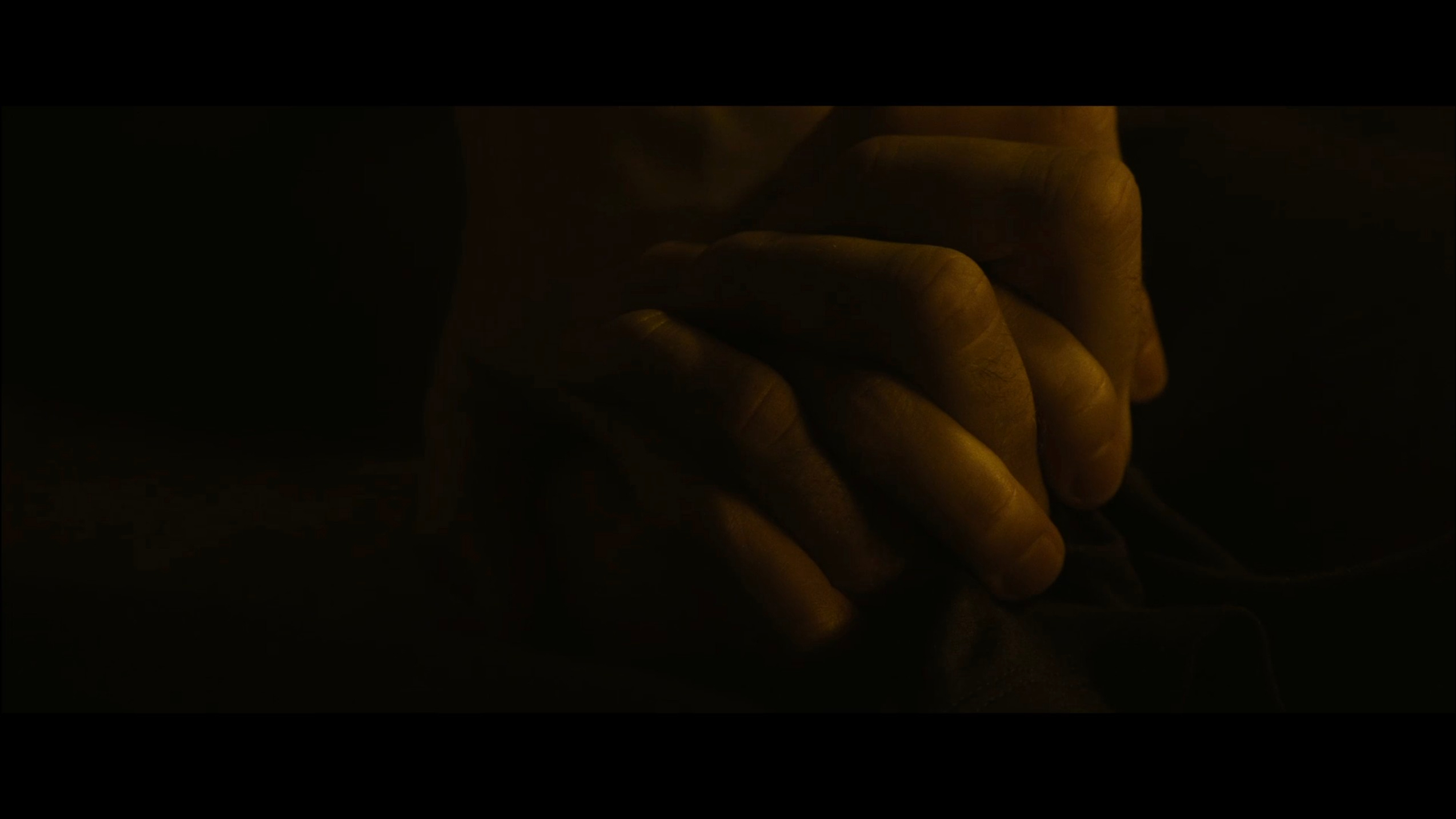
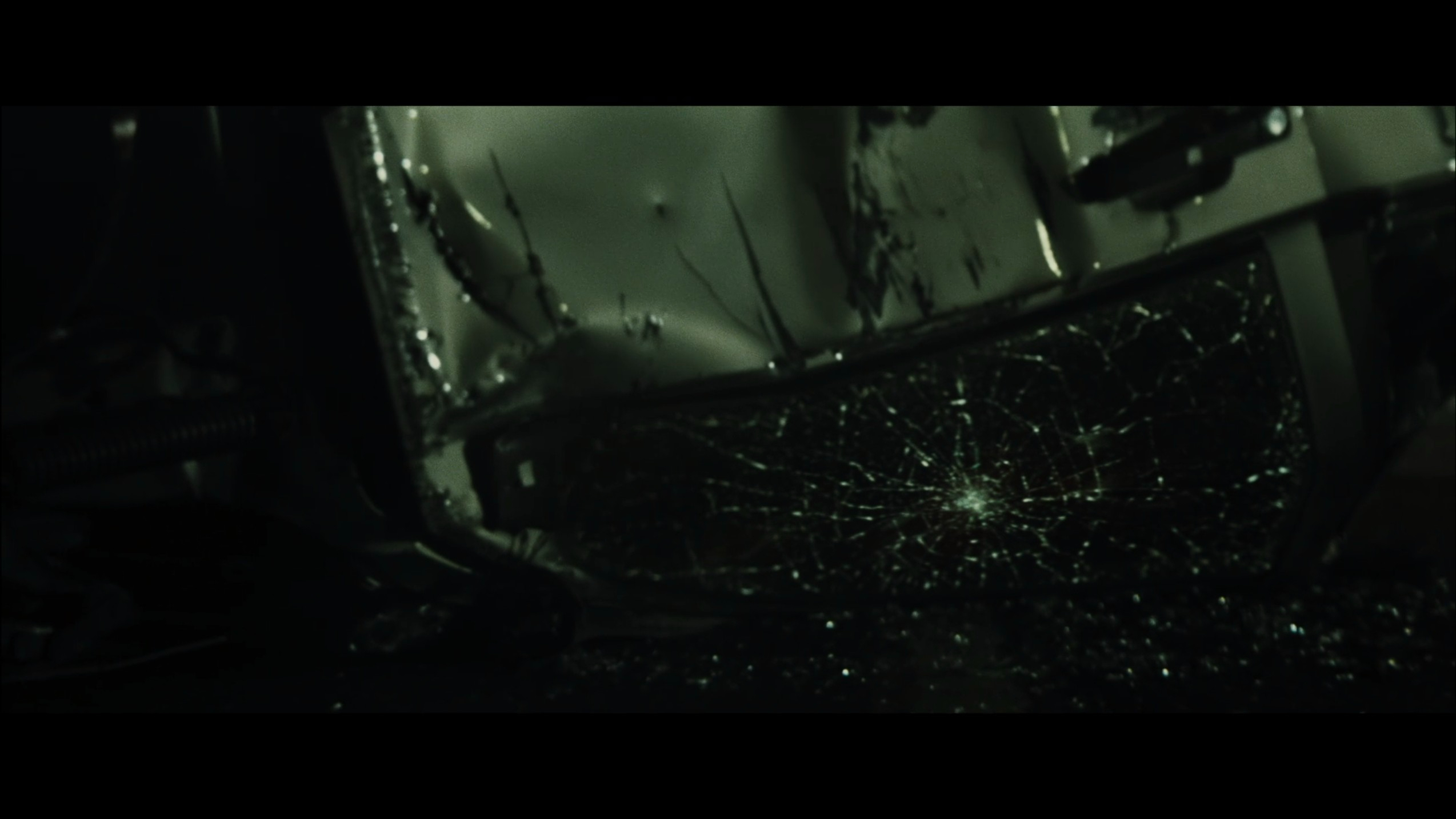
The interlocked fingers of Adam and Helen form something similar to the eight legs of a spider. While the shattered window of the car crash resembles a spider’s web. There’s definitely some symbolism here but nothing I think is objective enough to explain. It’s open to interpretation. What’s neat about it is that regardless of symbolism these moments subconsciously prime the viewer for Helen’s transformation into the spider. Those shots happen just a few minutes before. It’s one of the coolest uses of visual foreshadowing I’ve ever seen.
Timeline of events in Enemy
- BEFORE THE MOVIE
- Anthony is an only child.
- Becomes a history teacher.
- Along the way, meets Helen, dates Helen, marries Helen.
- A midlife crisis starts and Anthony gives acting a shot, he buys a motorcycle, and becomes a much more self-centered person.
- Helen’s pregnant.
- Anthony and Helen fight to the point Anthony moves out. With the idea being maybe they’ll work things out but, for now, they need some distance.
- Anthony starts dating Mary.
- He resumes teaching rather than trying to be an actor.
- THE MOVIE STARTS
- Anthony leads a double like. Sometimes he’s back home, with his wife, trying to work things out. Other times, he’s teaching, living separated from his wife, and with his girlfriend, Mary.
- Anthony shows his mom the apartment he’s living in during this period of separation. She leaves a voicemail voicing her concern.
- The weight of the separation from Helen eventually gets to him and he questions what kind of life he wants to lead. Does he want the actor, rebel, Mary life? Or the stable, professor, Helen life?
- He chooses Helen, returning to her.
- But we’re left to wonder if he’s actually a changed man or if he’ll only betray her trust once again?
What was the club?
It seems to be an underground gentlemen’s club. A pretentious version of the fight club in Fight Club. It’s a place where a diverse group of men shed the skin of their normal lives and observe the female form in a way that’s completely alien to their day to day. Essentially, they break the pattern of their lives and their typical interactions with women. They’re “free” of society’s standards. Of the metaphoric dictatorship. And that’s exciting. It’s thrilling. There’s a sense of power and authority they may not usually feel. So the club very much plays into the gender power dynamics that are core to Enemy. As well as just the sense of duality. There’s who these men are outside of the club, then who they are inside the club.
The main question I have is if the club is even real. I imagine clubs like it exist in the world. But I’m wondering if Anthony ever went to one. And, sure, we have the scene where the concierge who was with Anthony begs to return. That acknowledgement from an outside party would seemingly confirm the legitimacy of the club. But it’s plausible that’s just another one of Anthony’s subjective interpretations of what happened.
Either way, whether it exists or doesn’t, what the club symbolizes is the same. It’s somewhere male fantasy can go wild, hidden from the oversight of society and a wife’s judgment.
What was in the envelope?
When Adam first pretends to be Anthony, he only has the name from the credits of the movie Where There’s a Will There’s a Way. Daniel Saint Claire. That name leads to an acting website that shows Daniel as part of Volga Talent. At the offices of Volga Talent, Adam, mistaken for Daniel, receives the letter. But because Adam is a nice guy, he never opens the letter. He only uses it to get in contact with Anthony and even gives the letter, unopened, to Anthony. For a while, the letter’s forgotten. Until the last scene when Adam, as Anthony, puts on Anthony’s jacket and finds the envelope, opens it, because he’s comfortable doing that now, and discovers the key.
(Quick recap. It seems each time the club has an event, only a limited number of people receive access. If you receive a key, it means you’re invited. Anthony has one but his building concierge does not. Which is why the building concierge was asking to tag along with Anthony.)
So the whole time the envelope held the key for the next entrance to the club. Since we know Adam is actually just Anthony, that means “Adam” knew the key was in the letter the entire time. It actually means that “Adam” went to Volga to pick up the key. So the crisis between Anthony and Adam we see play out in the movie is really a crisis of what to do about the key. Does he reject his darker, id-driven urges? Or does he give in? When he’s able to put the key out of his mind, he gets back to being the man Helen originally fell in love with. But the moment he remembers the key, the moment he has the urge to go back to the club, things fall apart.
Is the picture of Adam the same picture of Anthony and Helen
Yes. It’s one of the main clue’s that Adam and Anthony are the same person. That Adam has the torn version of the photo that’s missing Helen is indicative of the fact he’s the one living separated from Helen.
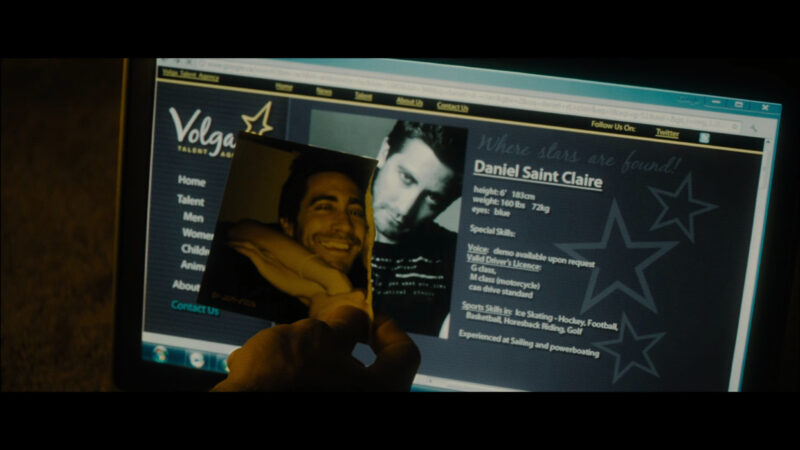
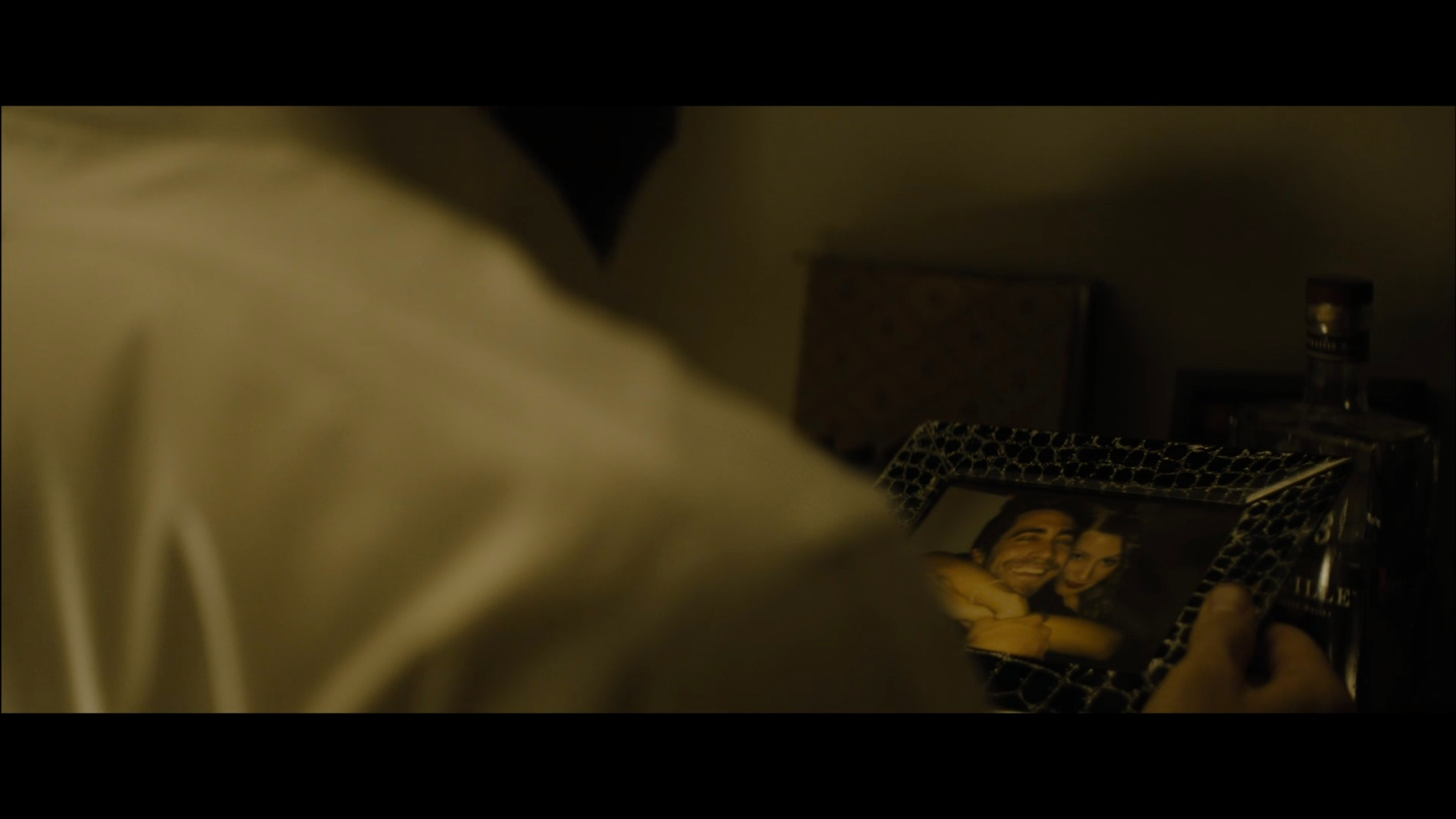
Daniel Saint Claire’s acting resume
- Daniel Saint Claire
- Volga Talent
- 6’ tall
- 160 lbs
- Blue eyes
- Driver’s License
- G Class,
- M class (motorcycle),
- Can drive standard
- Sports skills in: Ice skating, Hockey, Football, Basketball, Horseback Riding, Golf
- Credits
- Movies
- Where There’s a Will There’s a Way (2005)
- Bellhop 3
- Call Me L8R (2003)
- Waiter
- Passenger Without a Ticket (2000)
- Man on train
- Where There’s a Will There’s a Way (2005)
- Commercials
- Vitamin Water (2006)
- Tropicana (2004)
- Movies


U have left out the part where his mom tells him leave the fantasy of acting
Thank you Chris for the thorough analysis, it really encouraged me to watch Enemy again and helped me understand + enjoy the film. Here are some of my thoughts…
* I know this doesn’t exactly fit after the opening scene where Anthony listens to her mother’s message on the phone, but I’d like to think the part where we see the underground club for the first time could be the actual ending of the film, where the circle is complete, and he already made the decision to go to the club. We’re about to watch an iteration within an endless loop, which is the rest of the film.
* The scene where Anthony and Adam talk on the phone for the first time and Anthony tells Adam not to contact him again. After he hangs up, Helen confronts him: “Are you seeing her AGAIN?” His response: “I don’t want to talk about this AGAIN.” So, there’s a history of cheating. He probably returned to his wife, apologised, and told her it was over, but it wasn’t. Helen: “You’re lying.” In the film, we watch Adam and Anthony talking but maybe it REALLY is Mary Anthony has been talking to, and he’s, of course, lying.
* In a way, this is a Dr. Jekyll and Mr. Hyde story. We can see it in the way Anthony looks at Mary on the bus. The expression on his face tells us all. And then, he plots to steal her from Adam. The egoistic, evil side surfaces.
* Another clue worth mentioning: When Adam asks his mother about Anthony in her home, she tells him to “quit your fantasy about becoming a 3rd rate actor!”
* The scene where we watch Adam with Helen at home and Anthony with Mary at the hotel, then the car, simultaneously… The hotel + car part with Mary is all happening inside his head while repairing his relationship with his wife. At the end of this scene, after the accident, Adam and Anthony become one again.
* One last observation: Throughout the film, we see a lot of tall concrete buildings. Are these human webs?
* If I had to summarise the film with one sentence: “What would it look/feel like if our internal conflicts could be externalised?”
Appreciate you reading! I like that idea of the endless loop! The one detail I think pushes back on it is the friend who says “I need to go back”. It would seem he’s referencing the opening scene. But it doesn’t necessarily exclude the possibility of the first underground club being the ending. And, they would be going back to see something similar, so in some ways it is the end, if you want to get super existential about it lol.
Yeah, he definitely cheated before. I do think the scenes where he’s talking to his “other self” are really just moments he’s having that moral dilemma. So literally, he’s talking to Mary. But he’s having that internal strife and that’s what’s shown on screen.
Definitely a Jekyll and Hyde story!
Yeah, the hotel + car part definitely embodies a breakup. It’s just a question of if he broke up with her somehow in person or over the phone (at a different time) or if it’s what’s going on in his heart.
Good summary sentence!
I don’t know how much we should read into the buildings. As far as I’m aware, there’s not really an in-road that we could point to that would let us come up with a real evidenced-based argument. We just have some spider symbolism at different points of the film. If there was some dialogue or some other imagery then maybe that would work? As is, there’s not enough to go on that would make me feel comfortable claiming something. So my default answer would be “it just goes with a kind of brutalism-based visual aesthetic.”
You failed to mention the web motif, which represents his freedom. The spider being crushed at the beginning represents the freedom to spin his own web of deceit.
And history repeating itself as a farce is the ending. He’s about to do it again only this time he’s not tragically fooling himself.
It’s been a bit since I wrote the article but I don’t remember webs appearing throughout the movie? Do you just mean webs as in the web of lies he’s been weaving? As opposed to an actual visual of webs?
And regarding history repeating itself, I do have a paragraph where I say exactly that:
“So in Enemy, we’ve come full circle with Anthony. He started fractured. Went through the whole Adam/Anthony journey. Ended up reconnecting with his wife. And it seems like things will be better. All he has to do is NOT REPEAT THE SAME BEHAVIORS THAT COMPLICATED HIS LIFE IN THE FIRST PLACE. Put another way: break out of the pattern. How? Call his mom back. Throw away the key. Stay committed to his life with his wife. Instead, what does he do? He begins to weave another lie. He thinks he has to go out? Get real. He wants to go to the club. He’s falling victim to his carnal vices. Again. It’s the same thing that got him in trouble in the first place.”
He meant webs literally…there’s a scene with a broken glass car window after daniels crash that resembles a web…metaphorical web of lies too.
Very well written, it covers almost everything that happened in the film and it gave me new interesting POV wich made this film even a better one!